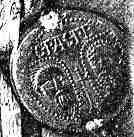




If you are looking at this page without frames, there is more information about medieval writing to be found by going to the home page (framed) or the site map (no frames).
| Papal Seals | ||||||
| The seals used by the papacy were always different, like other aspects of their documents. Papal seals were made not of sealing wax, but of lead, and were attached to the bottom of the document with cords. The seal was known as a bulla, which lead to official papal documents being called papal bulls. These documents came in various grades of importance, signified by aspects of the diplomatic, by the elaboration of the calligraphy, and by the means of attaching the seals. The most important documents had the seals attached with silk cords, while documents of lesser significance had them attached with hemp cords. Papal documents overflowed with visual symbolism. | ||||||
 |
Lead seals from a bull of Pope Leo IV, from AD 850. (Rome, Biblioteca Vaticana, Sala dei papiri, I) (From Steffens 1929) | |||||
| Until the 11th century, papal seals bore no images but were identified with only a simple written inscription. The seals illustrated above are inscribed with LEONIS on one side and PAPA on the other. As papal documents always bore complex authentication within the document itself, elaborate and unforgeable seals were probably not deemed to be required for ratification. | ||||||
| From the 11th century onward, the lead seals of the papacy bore an image, but a highly standardised one. The front of the seal showed the heads of Saints Peter and Paul, with a cross between them and the letters SPA and SPE above the heads. The image was thus not individualised for any particular pope, but represented the office. | ||||||
 |
At left, front of the seal on a bull of Innocent III, of 1208 to the monastery of St Luzi in Chur (Chur, Bischöfliches Archiv). At left, front of the seal on a bull of Pope Innocent IV of 1254 (Saint Gall, Stiftsarchiv, A.4.A.12). (From Steffens 1929) |
 |
||||
| The reverse of the seal carried a simple inscription with the name of the pope. | ||||||
 |
At left, reverse of the bulla on a bull of Pope Innocent II of 1138 (Trier, (Stadtbibliothek, Archiv, U.79). On the right, the reverse of the seal on a bull of Pope Eugenius III of 1145 (Trier, Stadtbibliothek, Archiv, Q.23). (From Steffens 1929) |
 |
||||
| While kings and emperors were developing larger and more and more elaborate seals, those of the papacy remained in a conservative tradition. However, from around the 12th century the documents themselves, or at least the most formal grade, became very large and complex, with complex symbols and monograms, and stylised and elaborate verbage. | ||||||
| Even into the 16th century, the basic design of the papal bulla remained the same, although the rendering of the heads might be seen to have something of a Renaissance appearance. | ||||||
| Obverse and reverse of the bulla of Pope Leo X, from 1517. (From de Boüard 1929) | ||||||
| The papal seals were not the only leaden bullae. They were also to be found in the Byzantine Empire and in Spain, as well as occasionally in other religious contexts. However, with their particular and consistent design, they are the most distinctive artifact of the papacy. | ||||||
|
|
||||||
|
|
||||||
|
If you are looking at this page without frames, there is more information about medieval writing to be found by going to the home page (framed) or the site map (no frames). |
||||||